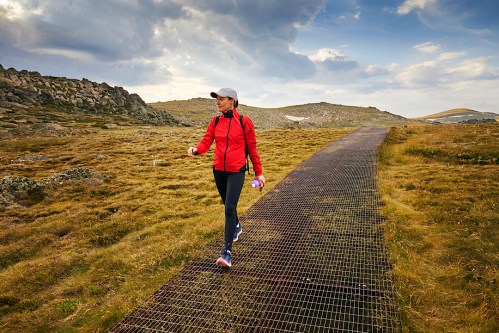Taking ‘Backward Walks’ Can Improve Your Balance, Coordination, and Stability in Ways Normal Walking Can’t
A certified trainer breaks down the benefits of walking backwards on a treadmill and how to safely add it to your fitness routine.

If you spend much time scrolling through TikTok, there’s a chance you’ve happened upon the recent trend of people walking backwards. Aside from looking rather bizarre, is there a reason for this switch up? Is good old-fashioned forward motion not enough anymore?
Experts in This Article
Steve Burden, CPT, is a certified trainer at The Fitness Tribe.
Steve Burden, a certified trainer, says the main benefit of walking backwards is that it’s more cardiovascularly and metabolically challenging for the body than walking normally. “This makes it an effective way to develop your cardiovascular system, without the kind of impact and strain associated with traditional activities that require you to move at a faster pace,” he explains. “It also offers a way to fit cardio into shorter sessions, as making your heart work harder means you won’t have to perform the activity for as long to achieve the same results.”
Burden adds that another benefit of walking backwards is that you have to focus harder and pay much more attention to what you are doing, since you can’t see where you are going. “This will help to improve your coordination and give you better control over your body,” he says. That coordination work can pay off. Studies show walking backwards can boost your balance as well. And, compared to forward walking, walking backwards places different stresses and demands on the muscles and joints in the lower body, helping build strength and reducing overuse injuries.
What are the physiological differences between walking forwards and backwards
Besides looking and feeling different, “the activation of muscles is slightly different when walking backwards, as you will use the hamstrings and anterior tibialis (shin) muscles much more than normal, and the quads and calves much less,” Burden says.
He explains that these differences are not only due to the fact that your legs are reaching behind you instead of in front, but also because you’re landing on a different part of your foot. According to Burden, this is the most important thing to focus on when you start walking backwards.
Form tips for walking backwards
“Each time you step backwards, you want to place your toes on the ground before your heel, in the opposite fashion to what you would do when walking forwards,” Burden advises. “This not only ensures all of the necessary muscles are being sufficiently activated, but also stops too much impact from going through your heel, which can damage your joints and even jar your spine.”
Secondly, Burden says you should focus on walking backwards with a balanced gait, even-length steps, and a smooth stride. Try to get into a rhythm with your stride, just as you do when you walk forwards because this will help you maintain your balance and keep a good pace.
Finally, he says you need to pay attention to your posture. “Many people will hunch or twist to try and see where they are going,” says Burden. “Make sure to stand tall, taking quick glances over your shoulder, if necessary, so that the muscles and joints stay in proper alignment.”
Safest way to walk backwards
Although the TikTok trend may only show people gushing about walking backwards on a treadmill, you can certainly walk backwards on regular ground. However, it may be more challenging and less safe.
“It is physiologically easier to walk backwards on a treadmill, rather than on normal ground because you won’t have to propel yourself backwards, as the ground is moving instead of you,” explains Burden. “It also has the advantage of you staying on one spot, so you don’t have to worry about bumping into people and objects. This is particularly important when walking backwards, as you won’t constantly have to be trying to see what is behind you.”
Burden adds that many people like walking on the treadmill due to the convenience of having your workout stats like your workout time, distance, and calories. It also offers the other main benefits of treadmill walking, such as causing less impact than regular walking and ensuring you know exactly what speed you are walking at.
How to get started walking backwards for exercise
Burden suggests that anyone who wants to try incorporating backwards walking into their workout routine should start by using a treadmill set at a slow speed so that you can just get used to the motion. You can use the arm rails for balance and won’t have to worry about bumping into things. As you get accustomed to the motion, you can increase the treadmill speed for your backwards walking workouts.
“Once you have complete confidence, you can then attempt to walk backwards outside,” advises Burden. “At this point you want to select a large, flat, quiet location, such as an empty field, where you can again begin to learn the intricacies of the new variation, without worrying about tripping or bumping into anyone or anything.” With that in mind, you’re ready to start putting your best foot backward.
Sign Up for Our Daily Newsletter
Get all the latest in wellness, trends, food, fitness, beauty, and more delivered right to your inbox.
Got it, you've been added to our email list.










